Gao Zongyu: Engineer and Designer of World-class Bridges
By staff reporter ZHOU LIN
PLANNED in 2003, construction of the 1,092-meter-long Shanghai-Nantong Railway Yangtze River Bridge – the world’s longest rail-cum-road cable-stayed steel bridge – started in 2014. On completion in 2019, it will span the 130 km. between the two cities, shortening to one hour the drive from Shanghai to Nantong.
Gao Zongyu, chief engineer of the China Railway Major Bridge Reconnaissance & Design Institute Co., Ltd. (BRDI) designed the bridge. In his illustrious career he has designed and overseen the construct of two dozen bridges.
The Long Game
“Early in the 1970s, world-class bridges were associated with Europe and the United States, and in the 1990s with Japan. But in the 21st century, China’s bridges polarize world attention.” This is a popular observation among experts in the bridge construction industry, where China is now predominant as regards the quantity and quality of bridges it constructs. Their long main spans correlate to the engineering complexity of their design and construction. China’s innovations in the bridge industry also command respect.
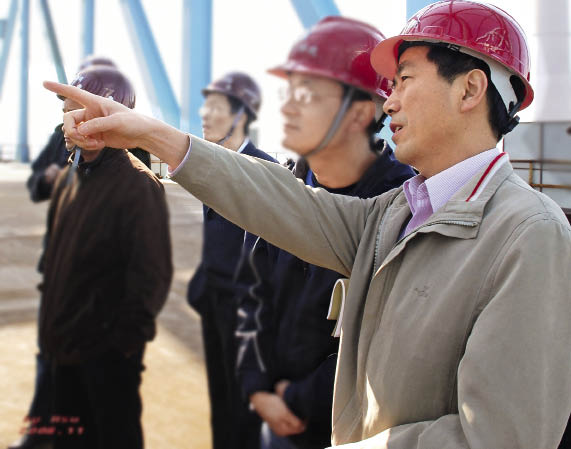
Gao Zongyu does field investigations at the bridge construction site.
Gao Zongyu announced at the 2012 International Bridge Science & Technology Forum (IBF) that the Shanghai-Nantong Railway Yangtze River Bridge, whose 1,092-meter main span is twice that of the Wuhan Tianxingzhou Rail-cum-road Yangtze River Bridge, will on completion be the world’s first of this type to exceed a length of 1,000 meters.
Aside from its 1,092-meter span, the Shanghai-Nantong Bridge has, at 325 meters, the world’s tallest main pylon. Its construction requires 480,000 tons of steel – equal to that needed for 12 Bird’s Nests (National Stadium in Beijing), and 2.3 million cubic meters of concrete, equal to that for eight National Theaters. Upon completion it will be capable of withstanding 150-166.44 km/h gales, an 8.0-magnitude earthquake, and a 100,000-ton ship collision. Piers 28 and 29 are crucial to the whole project. The caisson, or foundation, of bridge pier No. 29 is 56 meters tall and weighs more than 15,000 tons – 500 tons more than that of pier No. 28. It is the world’s biggest steel caisson.
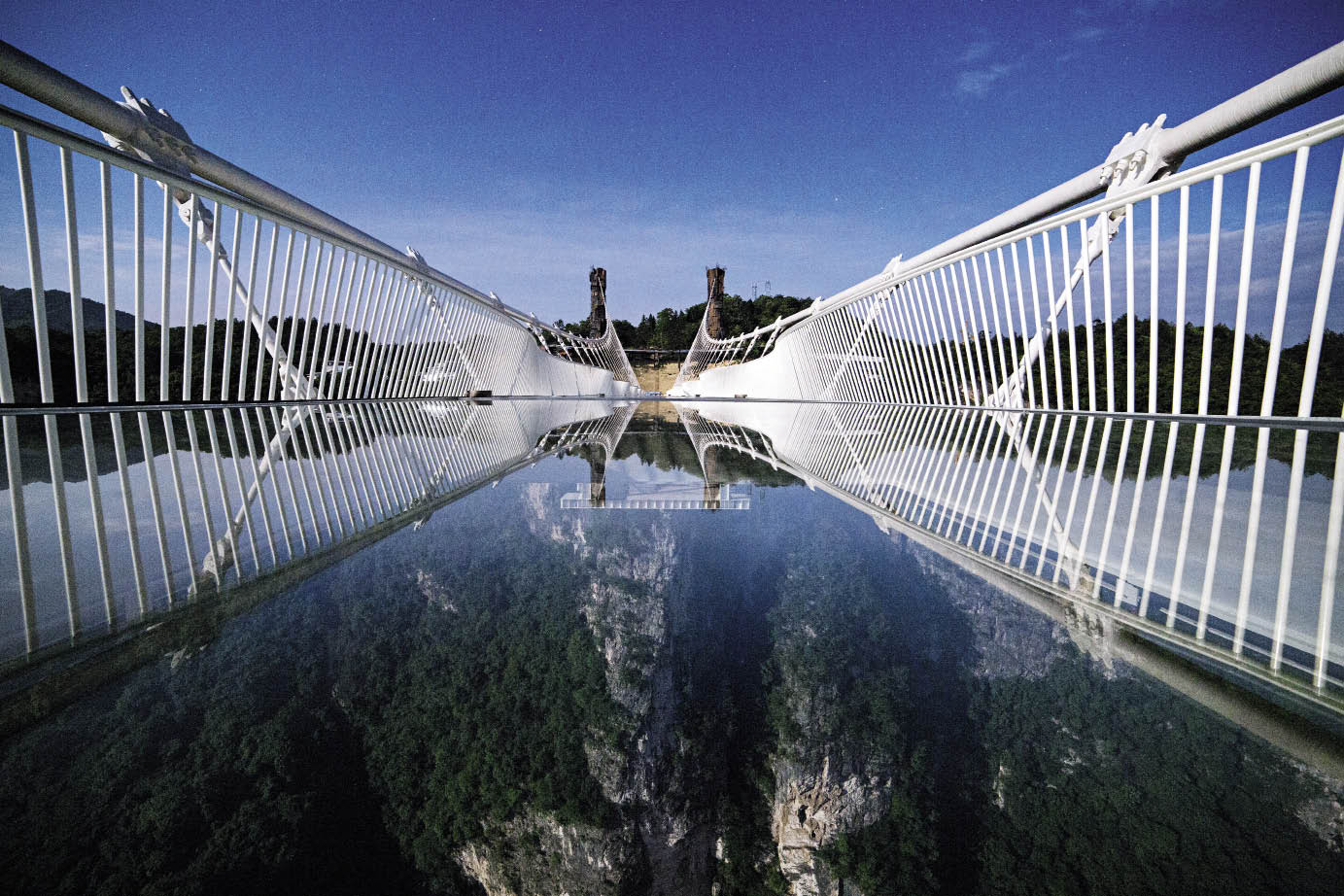
The world’s longest span glass bridge at Zhangjiajie Great Canyon.
The project’s scale and technical difficulties have resulted in world breakthroughs in national bridge building history. It represents the highest level of bridge construction technology in China and the world as a whole.
The field investigations that Gao Zongyu began in 2003 entailed frequent journeys between Wuhan, Nantong, and Shanghai.
“I considered 10 or more locations for the bridge, and finally focused on five. This was the most challenging task,” Gao Zongyu said. “We needed to give full consideration to multiple factors, including smooth transportation over the Yangtze River, local geological and hydrological conditions, flood prevention, the negotiation of highway and railways junctures, and demolition of surrounding land constructions.” Both Shanghai Municipality and Jiangsu Province are populous, well-developed areas where large construction projects may involve various stakeholders’ interests. This often makes them difficult to carry through. But the Shanghai-Nantong Railway, as a three-in-one inter-city railway, cross-province railway, and expressway which, if built separately, would cost RMB 10 billion more, is welcomed by all.”
Gao Zongyu’s colleagues say that whenever presented with a blueprint, he immediately spots any problems. Gao often observes, “Scientists make achievements in the laboratory through trial and error, but engineers cannot make even a minor mistake, as quality and safety are the bottomline of our designed projects.” Chair of the BRDI No.1 Design Institute Liu Hanshun recalled, “Gao Zongyu has never lost confidence over the past decades, no matter how big the project.”
Designated “National Design Master” in 2011, Gao was responsible for the first high-speed railway bridges spanning the Yangtze River and Yellow River. Also one of the chief designers of the Hangzhou Bay Bridge and East China Sea Bridge, he is an acknowledged expert in the design of large-size rail-cum-road bridges.
In 2014, the “Construction methodology for rail-cum-road cable-stayed steel bridge of triple main trusses & cable planes” that Gao devised won him the National Science & Technology Progress Award.
Innovation Despite Skepticism
The “Construction methodology for rail-cum-road cable-stayed steel bridge of triple main trusses & cable planes” was first applied to construction of the Wuhan Tianxingzhou Rail-cum-road Yangtze River Bridge. This was a milestone in Gao Zongyu’s engineering career.
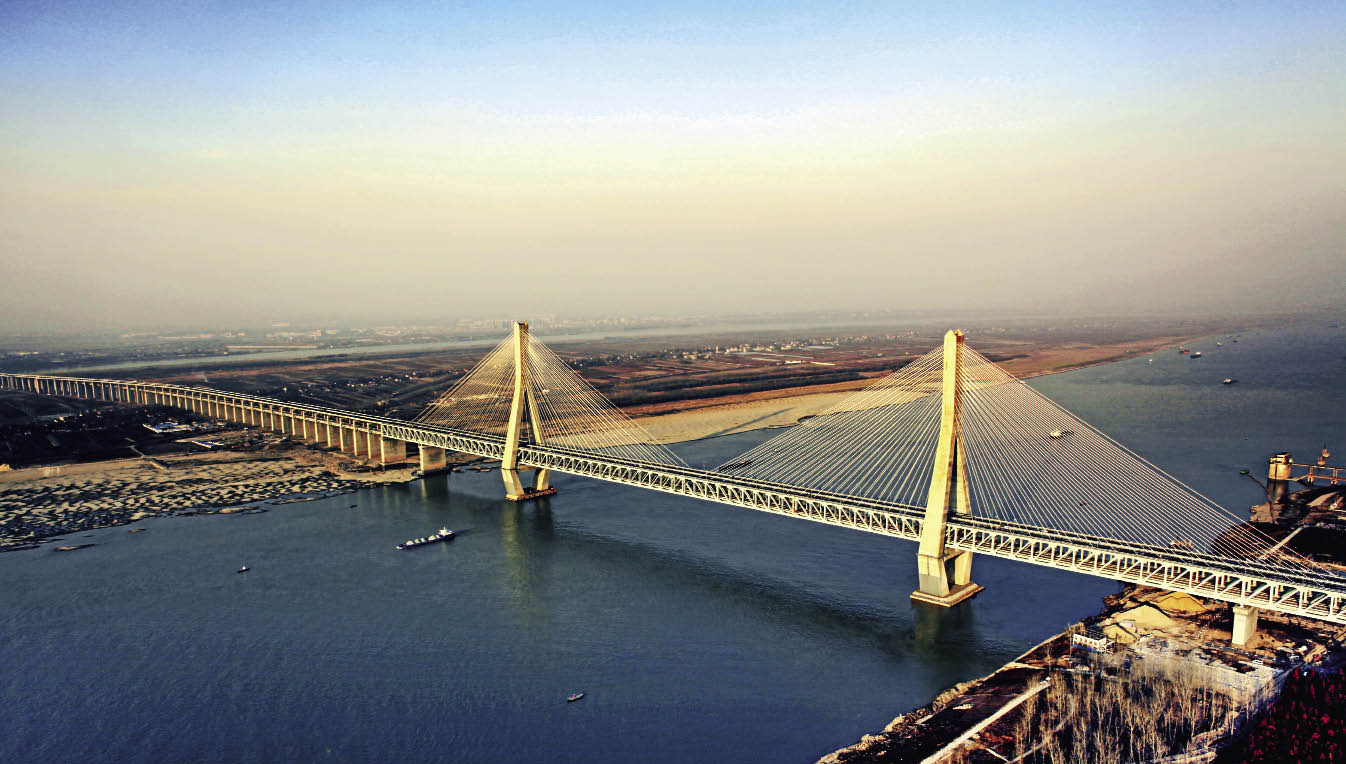
Tianxingzhou Bridge was awarded the George S. Richardson Medal at the 27th International Bridge Conference in 2010.
The structure of rail-cum-road bridges is usually one whereby vehicles drive above and trains run below. It is a far more complex design than that of a standard highway bridge because the weight of one train is equal to that of traffic on an eight-lane highway. Tianxingzhou Bridge was initially designed as a double-line railway. It then expanded to a triple-line railway, and then to a four-line railway with a six-lane highway, the total load of which was equal to that of a 34-lane highway.
Gao Zongyu holds that the success of Tianxingzhou Bridge lay in innovation, but the path to it was rocky.
Tianxingzhou Bridge was at that time the world’s longest span rail-cum-road cable-stayed steel bridge, and also the world’s first rail-cum-road bridge with a four-line railway. To build a conventional cable-stayed bridge with two cable planes, engineers needed to heighten the bridge as a whole and use even larger steel girders to strengthen the bridge framework.
Gao Zongyu and his team proposed adding one more cable plane and another main truss to enhance the bridge’s rigidity and load-carrying capacity.
This idea, however, immediately sparked searching questions from certain experts. They objected on the grounds that there had been no successful precedents; that the added cable plane would necessitate a more complicated structure whose stress would be hard to calculate; and that there were too many docking points for a cantilever installation, which would pose big construction challenges and risks.
Whether or not the new design was feasible depended on estimating the changes in stress as a result of adding another cable plane to the bridge.
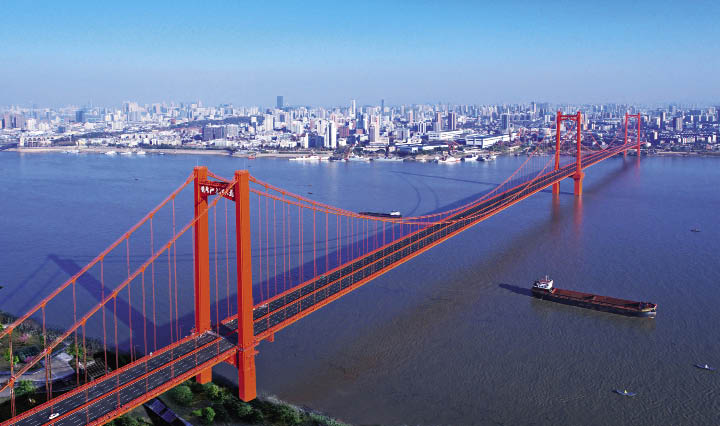
Yingwuzhou Bridge in Wuhan, the world’s first four-span suspension bridge with triple pylons and steel-concrete composite stiffening girders.
How was it possible to analyze and calculate the bridge stress? Taking into consideration Tianxingzhou Bridge’s double decks for three kinds of vehicles – automobiles, freight trains, and high-speed trains – Gao Zongyu and his team independently developed 3D bridge design software to collect and analyze data through simulating traffic. The team spent six months carrying out tests and making calculations. They reached the unexpected conclusion that the added middle main truss bore the same weight as the other two trusses, there being a less than 10 percent difference. This overturned the prevailing opinions and endorsed the new design.
Although everything had been proved in theory, some experts still harbored doubts about putting this theory into practice. Gao Zongyu and his team again did their utmost to find a solution. After working day and night, they finally developed a 700-ton-load automatic girder-erection crane to ensure the trusses’ precise positioning and assembly.
The new design was obviously both economical and feasible – it could potentially save 3,330 tons of steel as compared to the original plan. This was due to the highway and railway docks being one meter lower, which meant that the length of the two approach bridges on either side could be reduced, thus saving more than RMB 110 million in construction costs.
Gao Zongyu holds that innovation is necessary to overcome engineering difficulties. “We innovate to meet engineering needs rather than to try something novel.”
Span the Future
Gao Zongyu regards innovation as an eternal theme in China’s bridge design and building sector. “During the 1950-1960s, our aim was to learn from foreign countries in order to build our own bridges. When we built the Wuhan Yangtze River Bridge, Chairman Mao Zedong visited the site three times. On each occasion he would ask Chinese engineers whether they had understood and learned the core technology from Soviet specialists.” Nowadays, China’s bridge technology has developed so fast that, on the basis of safety, quality, and cost-saving, Chinese engineers attach most importance to durability, low-carbon, and environment-friendly materials, and the application of information technologies.
The cable-stayed structure software system that Gao Zongyu developed in the 1990s has been consistently upgraded to this day, “from designing small bridges to bigger ones; from simplified to detailed calculations; and from static to dynamic analyses.”
When Gao Zongyu designed the Qingzhou Minjiang River Bridge in 1998, the 605-meter-long main span bridge was topmost among the world’s steel-concrete composite cable-stayed bridges. Gao’s team took one year to develop a new software through which to make the precise computations that eventually reduced the steel products needed by 20 percent. They thus saved RMB 30 million in construction funds.
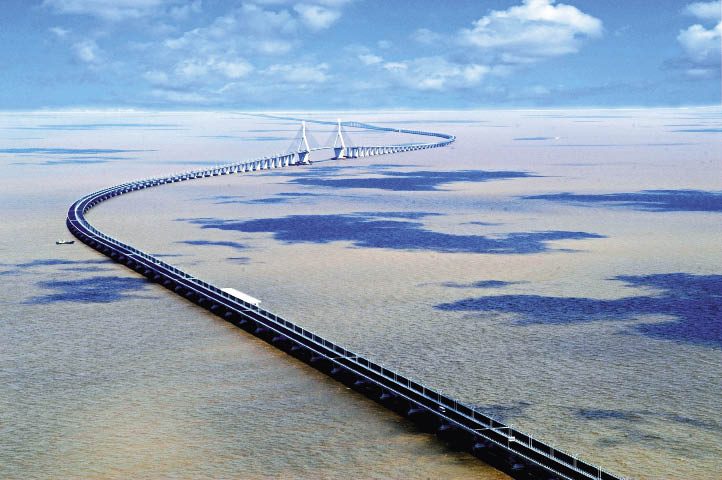
The 32-km-long East China Sea Bridge – China’s first cross-sea bridge.
In 2001, having designed China’s first cross-sea bridge – the East China Sea Bridge – Gao Zongyu faced the challenges of the highly corrosive nature of brine and the strong gales that buffeted the site for six months of the year. He boldly proposed prefabricating on land the 70-meter-span concrete box girder between two main bridge piers and transporting by special ferry each 2,000-ton girder and assembling them at sea. He initially put forward the concept of a “precast, integrity, factor” in bridge building, and at the same time increasing construction efficiency. The 32.5-km-long East China Sea Bridge was eventually completed in less than four years.
The rapid development of China’s high-speed railways in the new century forced Gao Zongyu to devote himself to research into long-span bridges incorporating high-speed railways running at more than 200 km per hour. Gao Zongyu led the design of both Wuhan Tianxingzhou Bridge and Zhengzhou Yellow River Bridge, on the Beijing-Guangzhou High-speed Railway route. The 504-meter-long Tianxingzhou Bridge was awarded the George S. Richardson Medal by the 27th International Bridge Conference in 2010.
Looking back on Gao Zongyu’s career, innovative thinking brought him countless achievements. He has won 20 or more awards at home and abroad, including two George S. Richardson Medals, six National Prizes for Science & Technology Progress, one National Excellent Engineering Design Award, and the 10th Zhan Tianyou Railway Science & Technology Award. He also has 12 patents to his name, has published 30-plus papers, and accomplished the construction of 24 masterpiece bridges, the most distant the Mohammed VI Bridge in Morocco.
Born in 1964, Gao Zongyu has specific goals to accomplish before retiring: Firstly, he would like to design China’s three great cross-sea bridges over the Qiong-zhou Strait, Bohai Strait, and Taiwan Strait; second, he wants China’s bridge engineers to participate in construction of the Belt and Road Initiative in other countries. They may then compete with their Western peers on the global market in such areas as bridge design, building, research, and consultation.
